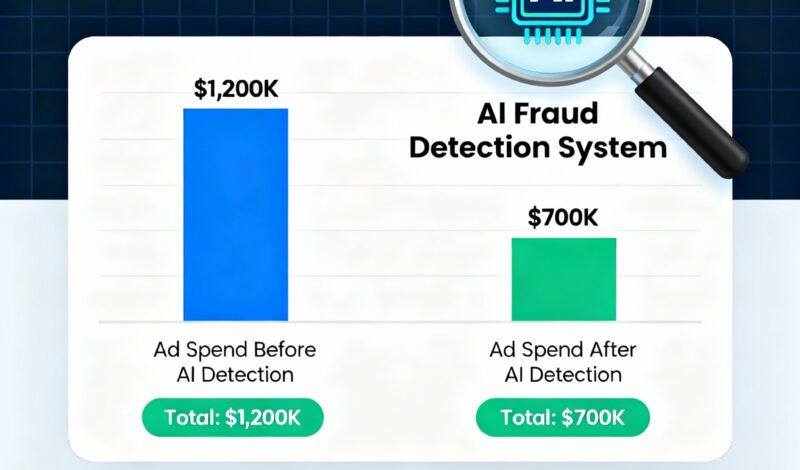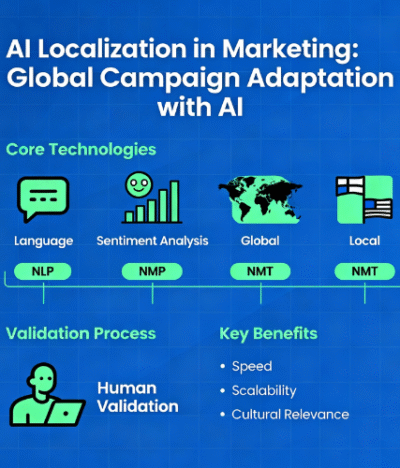The Rising Threat of Ad Fraud
Digital advertising is booming, with global ad spend expected to reach $650 billion by 2026. However, up to 20% of online ad traffic is estimated to be fraudulent, according to industry studies. AI ad fraud detection is becoming essential for marketers to identify and prevent fraudulent activity, from click fraud and fake impressions to bot-generated leads and cookie stuffing, all of which inflate metrics and drain marketing budgets.
Traditional fraud detection methods, such as static filters and manual audits, cannot keep pace with the sophistication of modern ad fraud. AI solutions offer real-time monitoring, predictive insights, and automated protection to safeguard campaigns and ROI.
How AI Detects Fraud in Digital Ads
AI leverages machine learning, anomaly detection, and predictive analytics to identify patterns of fraudulent activity. Unlike static rules, AI learns continuously from campaign data and adapts to new fraud tactics.
Key approaches include:
- Behavioral Analysis: AI tracks user behavior across multiple interactions — clicks, page views, and session duration — to detect suspicious patterns, such as multiple clicks from the same IP or unusual browsing speed.
- Bot Detection: AI distinguishes human users from automated bots by analyzing factors like mouse movement, typing patterns, device fingerprints, and session timing.
- Click Pattern Modeling: By comparing historical data, AI identifies anomalies in CTR, conversion rates, and engagement that may indicate fraud.
- Device & Network Fingerprinting: Identifies unusual devices, proxies, or VPN traffic that often correlate with fraudulent activity.
- Predictive Detection: Machine learning models can forecast likely sources of fraud, allowing marketers to proactively block high-risk traffic before it consumes budget.
This combination of techniques enables early detection, reducing the impact of fraud before it affects performance metrics.
Real-World Examples of AI in Action
Case Study 1: E-Commerce Platform
An e-commerce company running multiple Google and Meta campaigns noticed a sudden spike in clicks without corresponding sales. AI fraud detection flagged 65% of clicks as bot-driven. After blocking these sources:
- Wasted ad spend decreased by $120,000/month
- Campaign ROAS improved by 28%
- The team gained accurate insights into legitimate audience behavior
Case Study 2: Mobile App Install Campaigns
A mobile gaming company experienced high install volumes from a new region but saw very low engagement. AI detection revealed click farms generating fake installs. By reallocating spend toward high-quality traffic:
- Conversion quality increased by 40%
- User retention improved due to authentic engagement
- Marketing strategy became more data-driven
Case Study 3: Programmatic Display Ads
A global brand using programmatic ads noticed inflated impression metrics. AI ad fraud detection identified domain spoofing, where fraudulent websites claimed to be premium publishers. By blocking these domains, the brand:
- Saved $50,000 in monthly spend
- Maintained transparency with programmatic partners
- Protected brand safety
Benefits of AI Ad Fraud Detection
- Budget Protection: Prevents wasted spend on fake clicks, leads, or impressions.
- Accurate Campaign Metrics: Ensures reporting reflects real human engagement, improving decision-making.
- Real-Time Intervention: Fraudulent activity is flagged instantly, preventing prolonged damage.
- Scalability: Works across multiple campaigns, platforms, and channels without additional manpower.
- Enhanced Brand Safety: Prevents ads from appearing on fraudulent or inappropriate websites.
Tools & Platforms for AI Fraud Detection
Several platforms specialize in AI-driven fraud protection:
- DoubleVerify: Real-time monitoring of invalid traffic across channels.
- Forensiq (Impact): AI-based pre-bid and post-bid fraud prevention.
- White Ops / Human Security: Machine learning solutions for bot traffic prevention.
- Protect360 by AppsFlyer: Mobile-first AI fraud detection for app install campaigns.
These platforms integrate with ad networks, DSPs, and analytics platforms to provide centralized protection, ensuring marketers can focus on strategy rather than manual monitoring.
Challenges in Implementing AI Fraud Detection
- Data Quality: Inaccurate or fragmented data can reduce AI efficiency. Integrate CRM, ad, and web data for a complete view.
- False Positives: Overzealous filters may block legitimate traffic, affecting conversions. Continuous tuning is required.
- Cost and Complexity: Enterprise-level AI tools require investment and skilled personnel for monitoring and integration.
Best Practice: Start by applying AI detection to high-value campaigns, gradually expanding coverage while continuously reviewing flagged activity to maintain accuracy.
The Future of AI in Ad Fraud Prevention
AI is evolving from reactive detection to predictive and autonomous prevention. Future systems will:
- Predict fraudulent behavior before campaigns launch
- Automatically adjust bids, targeting, and ad placements
- Learn continuously from cross-channel patterns to prevent new fraud tactics
Brands that adopt AI-driven fraud detection early will maximize ROI, protect brand reputation, and maintain data integrity, gaining a competitive advantage in the digital advertising ecosystem.
Takeaway
Ad fraud is a growing and sophisticated challenge in digital marketing. AI ad fraud detection empowers marketers to identify suspicious activity, prevent wasted spend, and ensure accurate performance metrics.
By leveraging AI, marketers can make data-driven decisions with confidence, focusing budgets on real, high-quality engagement rather than fraudulent clicks. In an increasingly complex advertising environment, AI is no longer optional — it’s essential for securing campaigns and safeguarding ROI.




